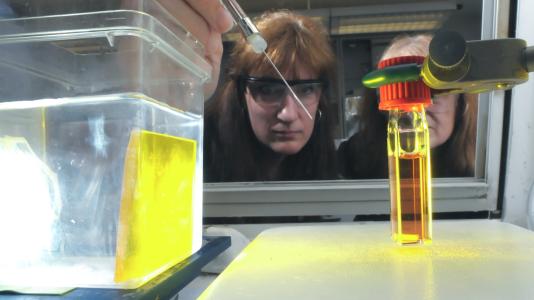
A group of scientists at the U.S. Department of Energy’s Argonne National Laboratory, led by chemist Lisa Utschig, has linked platinum nanoparticles with algae proteins, commandeering photosynthesis to produce hydrogen instead. The system produces hydrogen at a rate five times greater than the previous record-setting method.
“If you are considering the question ‘How do we get energy from the sun,’ you always come back to photosynthesis,” Utschig said. “Photosynthesis does it best. It’s been engineered over millions of years.”
Utschig and fellow chemist David Tiede are part of Argonne’s Photosynthesis Group, which has worked for fifty years to understand photosynthesis—one of the most mysterious and wonderful chemical processes in the world. Photosynthesis built a green Earth out of the bare, meteor-blistered planet which had sat empty for a billion years; it tipped the composition of the atmosphere towards oxygen, allowing all kinds of life to blossom, including us.
The chemistry group is part of a larger effort to develop efficient ways to produce what are termed solar fuels. Most people think of solar panels when they think of solar energy, but the energy that solar panels generate has to be used right away—they directly create electricity, which can’t be stored easily.
The alternative is solar fuels, which pull energy from the sun to create fuel that can be stored for later, such as hydrogen. Hydrogen, a promising fuel in the effort to reduce carbon dioxide emissions, is appealingly clean: when it’s burned as fuel, water is the byproduct. But we have yet to discover a low-cost way to manufacture large amounts of hydrogen.
“Basically, we’ve been reverse-engineering photosynthesis,” said Tiede, who co-authored the paper. “If we understand how Nature does it, we can tweak the process to produce hydrogen.”
Most solar fuel efforts focus on a type of protein complex called Photosystem I, or PSI, which is the first half of the photosynthetic duo found in all green plants.
When light strikes the PSI complex, it momentarily knocks an electron into an “excited” state. The goal is to separate this electron from its home atom—leaving behind a “hole” of positive charge—and channel it to an artificial catalyst to make hydrogen. But the electron only remains excited for the tiniest fraction of a second; the catalyst needs to grab it during this tiny window.
With co-author Nada Dimitrijevic, the team designed platinum nanoparticle catalysts. These catalysts have a size and surface chemistry that allows them to stick to PSI molecules at the point where the light-generated electrons accumulate. When the modified platinum nanoparticles and PSI are mixed in water, the two link together.
“The platinum nanoparticles have the same size and surface charge as the molecule that PSI would bind to naturally,” Tiede said.
Because the study design used platinum as a catalyst, which is too expensive to be cost-effective, the research serves as proof-of-concept. Further studies hope to improve the method’s efficiency, reliability and economics.
“The next step we’ll take is experimenting with non-platinum catalysts,” Utschig said. “Hopefully we can find a catalyst that can be made with a cheaper metal, which would make the process much more attractive on a large scale.”
The paper, “Photocatalytic Hydrogen Production from Noncovalent Biohybrid Photosystem I/Pt Nanoparticle Complexes,” was published in the Journal of Physical Chemistry Letters and is available online.
The research was supported by the Division of Chemical Sciences, Geosciences, and Biosciences of the U.S. Department of Energy’s Office of Basic Energy Sciences.